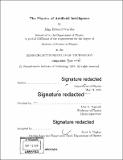| dc.contributor.advisor | Max E. Tegmark. | en_US |
| dc.contributor.author | Peurifoy, John Edward. | en_US |
| dc.contributor.other | Massachusetts Institute of Technology. Department of Physics. | en_US |
| dc.date.accessioned | 2019-11-12T17:38:09Z | |
| dc.date.available | 2019-11-12T17:38:09Z | |
| dc.date.copyright | 2018 | en_US |
| dc.date.issued | 2018 | en_US |
| dc.identifier.uri | https://hdl.handle.net/1721.1/122844 | |
| dc.description | Thesis: S.B., Massachusetts Institute of Technology, Department of Physics, 2018 | en_US |
| dc.description | Cataloged from PDF version of thesis. | en_US |
| dc.description | Includes bibliographical references (pages 83-87). | en_US |
| dc.description.abstract | In this thesis, I explore both what Physics can lend to the world of artificial intelligence, and how artificial intelligence can enhance the world of physics. In the first chapter I propose a method to use artificial neural networks to approximate light scattering by multilayer nanoparticles. This neural network model is experimentally shown to describe the system well, and is then further used to solve the inverse design problem and propose a generalized template for how to use neural networks to enhance numerical calculations. In the second and third chapter I explore the use of Unitary matrices in neural networks to attempt to solve the exploding and vanishing gradient problem. The norm-preserving property of unitary matrices is shown through experiments to allow neural networks to retain information over many more layers. This model achieves state of the art results on a number of toy and real world tasks. | en_US |
| dc.description.statementofresponsibility | by John Edward Peurifoy. | en_US |
| dc.format.extent | 87 pages | en_US |
| dc.language.iso | eng | en_US |
| dc.publisher | Massachusetts Institute of Technology | en_US |
| dc.rights | MIT theses are protected by copyright. They may be viewed, downloaded, or printed from this source but further reproduction or distribution in any format is prohibited without written permission. | en_US |
| dc.rights.uri | http://dspace.mit.edu/handle/1721.1/7582 | en_US |
| dc.subject | Physics. | en_US |
| dc.title | The physics of artificial intelligence | en_US |
| dc.type | Thesis | en_US |
| dc.description.degree | S.B. | en_US |
| dc.contributor.department | Massachusetts Institute of Technology. Department of Physics | en_US |
| dc.identifier.oclc | 1126279094 | en_US |
| dc.description.collection | S.B. Massachusetts Institute of Technology, Department of Physics | en_US |
| dspace.imported | 2019-11-12T17:38:08Z | en_US |
| mit.thesis.degree | Bachelor | en_US |
| mit.thesis.department | Phys | en_US |
